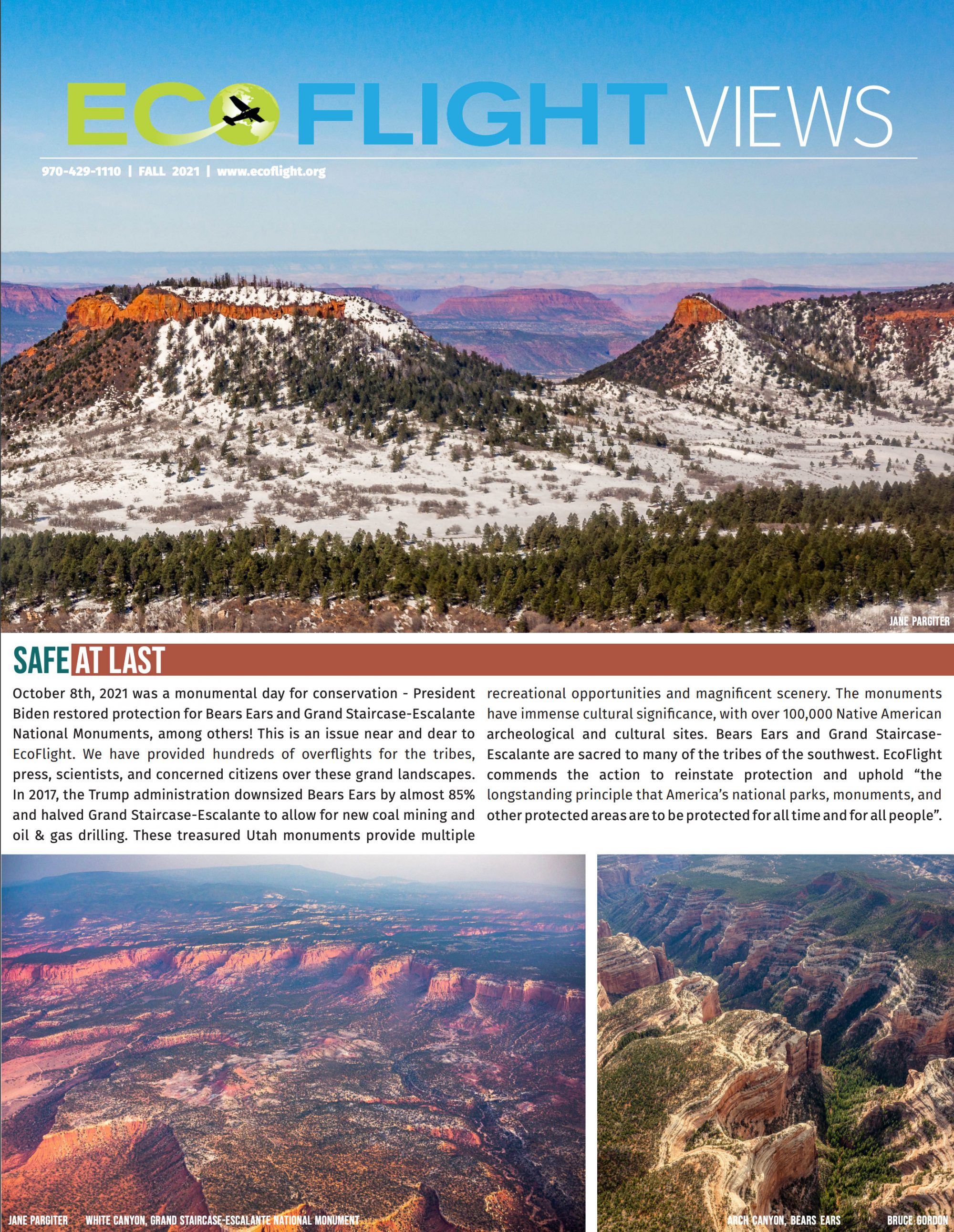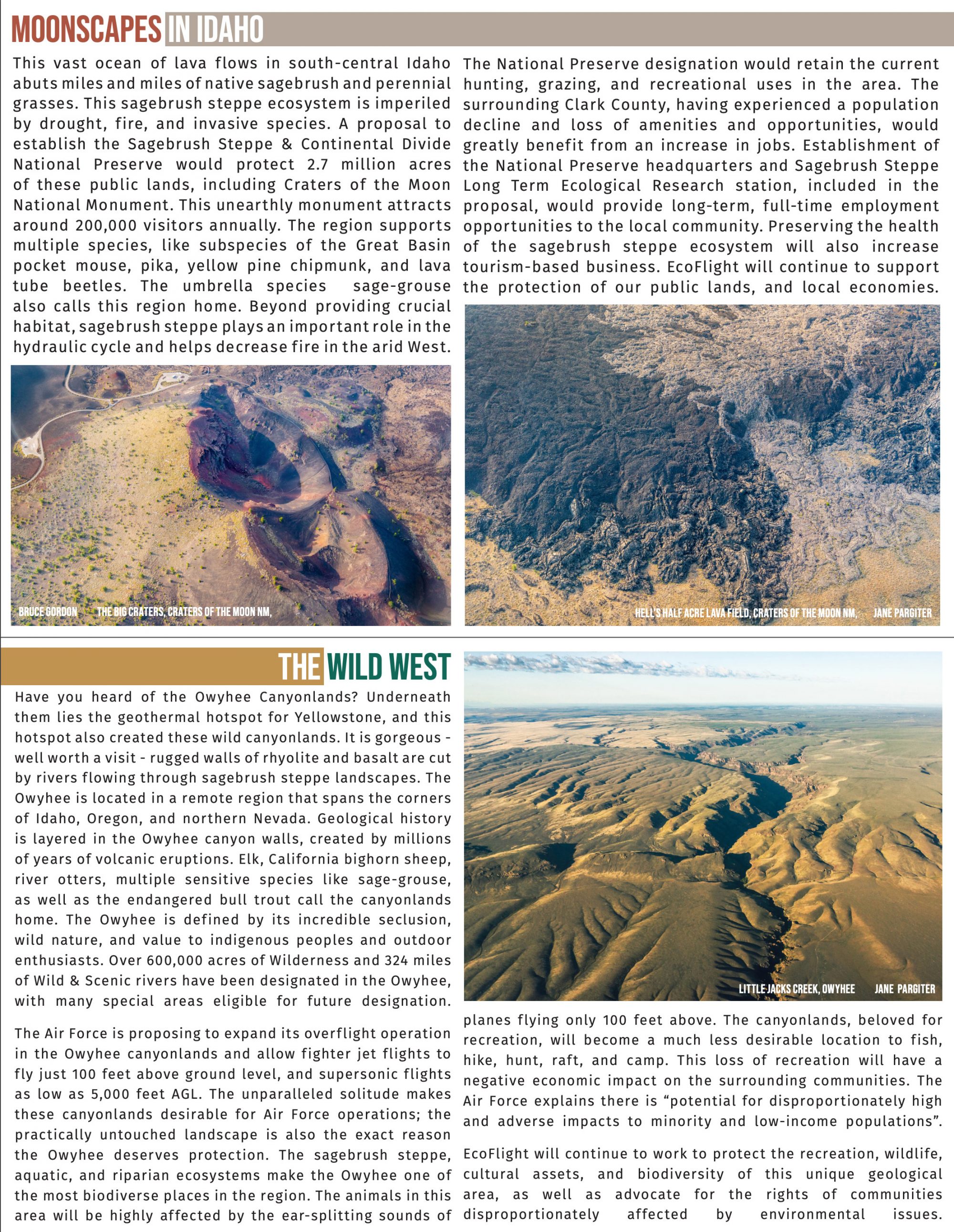



Text Only Version
Safe at Last
October 8th 2021 was a monumental day for conservation – President Biden restored protection for Bears Ears and Grand Staircase-Escalante National Monuments, among others! This is an issue near and dear to EcoFlight. We have provided hundreds of overflights for the tribes, press, scientists, and concerned citizens over these grand landscapes. In 2017, the Trump administration downsized Bears Ears by almost 85% and halved Grand Staircase-Escalante to allow for new coal mining and oil & gas drilling. These treasured Utah monuments provide multiple recreational opportunities and magnificent scenery. The monuments have immense cultural significance, with over 100,000 Native American archeological and cultural sites. Bears Ears and Grand Staircase-Escalante are sacred to many of the tribes of the southwest. EcoFlight commends the action to reinstate protection and uphold “the longstanding principle that America’s national parks, monuments, and other protected areas are to be protected for all time and for all people”.
Moonscapes in Idaho
This vast ocean of lava flows in south-central Idaho abuts miles and miles of native sagebrush and perennial grasses. This sagebrush steppe ecosystem is imperiled by drought, fire, and invasive species. A proposal to establish the Sagebrush Steppe & Continental Divide National Preserve would protect 2.7 million acres of these public lands, including Craters of the Moon National Monument. This unearthly monument attracts around 200,000 visitors annually. The region supports multiple species, like subspecies of the Great Basin pocket mouse, pika, yellow pine chipmunk, and lava tube beetles. The umbrella species sage-grouse also calls this region home. Beyond providing crucial habitat, sagebrush steppe plays an important role in the hydraulic cycle and helps decrease fire in the arid West.
The National Preserve designation would retain the current hunting, grazing, and recreational uses in the area. The surrounding Clark County, having experienced a population decline and loss of amenities and opportunities, would greatly benefit from an increase in jobs. Establishment of the National Preserve headquarters and Sagebrush Steppe Long Term Ecological Research station, included in the proposal, would provide long-term, full-time employment opportunities to the local community. Preserving the health of the sagebrush steppe ecosystem will also increase tourism-based business. EcoFlight will continue to support the protection of our public lands, and local economies.
The Wild West
Have you heard of the Owyhee Canyonlands? Underneath them lies the geothermal hotspot for Yellowstone, and this hotspot also created these wild canyonlands. It is gorgeous – well worth a visit – rugged walls of rhyolite and basalt are cut by rivers flowing through sagebrush steppe landscapes. The Owyhee is located in a remote region that spans the corners of Idaho, Oregon, and northern Nevada. Geological history is layered in the Owyhee canyon walls, created by millions of years of volcanic eruptions. Elk, California bighorn sheep, river otters, multiple sensitive species like sage-grouse, as well as the endangered bull trout call the canyonlands home. The Owyhee is defined by its incredible seclusion, wild nature, and value to indigenous peoples and outdoor enthusiasts. Over 600,000 acres of Wilderness and 324 miles of Wild & Scenic rivers have been designated in the Owyhee, with many special areas eligible for future designation.
The Air Force is proposing to expand its overflight operation in the Owyhee canyonlands and allow fighter jet flights to fly just 100 feet above ground level, and supersonic flights as low as 5,000 feet AGL. The unparalleled solitude makes these canyonlands desirable for Air Force operations; the practically untouched landscape is also the exact reason the Owyhee deserves protection. The sagebrush steppe, aquatic, and riparian ecosystems make the Owyhee one of the most biodiverse places in the region. The animals in this area will be highly affected by the ear-splitting sounds of planes flying only 100 feet above. The canyonlands, beloved for recreation, will become a much less desirable location to fish, hike, hunt, raft, and camp. This loss of recreation will have a negative economic impact on the surrounding communities. The Air Force explains there is “potential for disproportionately high and adverse impacts to minority and low-income populations”.
EcoFlight will continue to work to protect the recreation, wildlife, cultural assets, and biodiversity of this unique geological area, as well as advocate for the rights of communities disproportionately affected by environmental issues.
Deer with Big Ears
Baggs is a tiny town in southern Wyoming with a population of less than 500 people. Last year this small community attracted over 3,000 mule deer hunters between October 1st and 14th. Hunting is vital to the local economy. The Baggs mule deer are one of the few stable and healthy herds in Wyoming. This herd is within management population objectives, largely thanks to the high-quality habitat from the valley floor to the high country in the Sierra Madres and Zirkel Mountains in Colorado. These iconic mule deer with their large mule-like ears and bright, white rumps have collar monitors to track migration patterns. The lifeblood of these complex migrations are healthy, intact ecosystems. Mule deer migrate through vast tracts of aspens, Wyoming sagebrush, antelope bitterbrush, serviceberry, mountain mahogany, and Gambel oak.
With increasing pressures from energy and urban development, these migrations are becoming more difficult. Habitat is fragmented by roads, drilling sites, fences and other development. Recent science has discovered well pads have a significant impact on deer numbers, and can disturb migration and foraging behaviors.
The health of the Baggs herd is dependent upon proper management. Wyoming Governor, Mark Gordon, instituted a mule deer Working Group to support herd populations, protect landowner rights, and accommodate multiple land-use needs. EcoFlight partnered with Wyoming Wildlife Federation and Wyoming Game and Fish Department to further their understanding of the Baggs mule deer habitat and inform stakeholders. The aerial perspective is critical to understanding the health of these ecosystems.
Partner Spotlight
Joy Bannon is a policy advisor, analyst, and advocate for wildlife, habitat, and outdoor recreation throughout Wyoming. She has worked for Wyoming Wildlife Federation since 2007, and is dedicated to conserving landscapes and waterways for hunters and anglers. As a sportswoman and mom, Joy enjoys sharing the great outdoors with her children through hunting, long hikes, camping, fishing, rock climbing, skiing, and relishing in nature’s diversity.
Joy has organized dozens of flights with stakeholders and decision-makers, including state elected officials and wildlife managers, senators and the WY governor, over valuable wildlife habitat and landscapes in Wyoming. From big game migration corridors and greater sage-grouse lands to places of high conservation concern, such as the Greater Little Mountain Area and the Bridger-Teton National Forest, the Federation and EcoFlight highlight the importance of responsibly managing these natural resources.
“These flights provide a different, and crucial perspective and have led to deeper conversations about place, increased familiarity for decision makers as they consider management, and support for conservation. EcoFlight’s partnership with WWF is helping keep Wyoming wild for generations to come.” said Bannon.
President Letter
As a very famous Yankee baseball player once quipped, “It ain’t over till it’s over”. I think of this when I contemplate the state of the pandemic, and then I contemplate it as I load passengers in the plane, ensuring they adhere to our strict COVID protocol.
It is indeed a pleasure to see our smiling colleagues again, and work with the conservation community to fly politicos, scientists and concerned citizens over these important issues you will read about in this newsletter, a sampling of our exciting and timely missions.
Our work continued through the heart of the pandemic sans passengers but the video content we brought back and distributed through our partners was impactful at educating and advocating for conservation issues, as we started to move from defense to offense with the change in administrations.
The declaration once again to fully designate Bears Ears National Monument was a testimony to how perseverance pays off. During 2021 we flew for a number of other areas also being considered for National Monument status. Avi Kwa Ame near Lake Havasu is a special landscape that is sacred to many tribes, and is the missing link connecting the California desert to the Colorado River Plateau. This area, if protected, will play an essential role in climate adaptation for multiple species.
Walker Ridge is a hidden gem and well-kept secret near Sonoma, California, and a potential for expanded monument status, to be included in the Berryessa Snow National Monument.
With the addition of passengers in the plane, another whole aspect of conservation aviation becomes apparent and it is once again a delight listening to passengers and “conducting conservation conversations in the cockpit”. It’s a perfect platform to express ideas and passengers are stimulated by the compelling views of the issues in question.
Seeing the expressions on people’s faces behind their masks, while flying over the Owyhee Canyonlands of Oregon and Idaho, emphasized for me the wonder of these dramatic canyons, and the threats to the wildness of these places.
Over the Craters of the Moon, you can see where the area got its name, and we hear the passion of our passengers, who are working on expanding protections to this entire landscape of sagebrush steppe.
It is inspiring to share the aerial perspective with our committed partners, as we highlight the challenges of educating the general public about what is occurring on these conservation frontiers, and what might be the epochal future of these wild landscapes.
Meet EcoFlight’s Newest Team Members
The last two years have made it clear that EcoFlight’s digital content is highly effective, and the unique perspective in our images and videos is becoming more and more utilized by our partners. EcoFlight recently hired two new team members to help make the best use of our photo and video content and amplify the outreach and impact of the advocacy campaigns we fly.
Amanda comes to us from Boise, ID where we met her on one of our overflights that she helped organize for the Idaho Conservation League. Amanda has a degree in Environmental Studies, experience working with environmental organizations, and a passion for the outdoors. She brings a fresh perspective and intellect to EcoFlight that will help propel our advocacy and outreach to the next level.
Ben is a fusion of outdoor athlete, creative storyteller and conservationist. He blends his skills and passions at EcoFlight to bring a professional touch and polished look to all of our visual content. Ben grew up in Fort Collins, CO and moved to the mountains to study photography, where he wound up as a student on our Flight Across America program, learning about (and photographing) the West’s complex challenges with water and drought. Ben produces videos and photos that EcoFlight and our partners use to educate and advocate for the protection of our nation’s wild places.